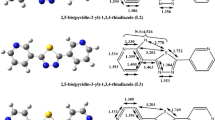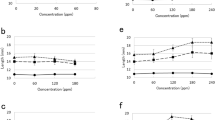Abstract
The effect of several analogs of 1-triacontanol (TRIA), differing in C-chain length (16–32), the position of the hydroxyl group and the terminal functional group, were tested alone and in combination with TRIA on the growth of rice (Oryza sativa L.), maize (Zea mays L.) and tomato (Lycopersicon esculentum Mill.) seedlings. Applied alone, none of the compounds caused an increase in growth; thus, chain length (30 C) and presence and position (terminal) of the hydroxyl group appear to be specific for the growth-promoting activity of TRIA. When applied simultaneously with TRIA, all analogs inhibited the response to the latter in all three test plants, whether applied in the nutrient solution, as foliar spray or by seed soaking. 1-Octacosanol inhibited the response of rice seedlings to 2.3 x 10-8 M TRIA at concentrations as low as 2.4 x 10-12 M. Thus preparations of TRIA and application equipment must be free from trace amounts of other long-chain compounds if they are to be used to increase plant growth.
Similar content being viewed by others
Abbreviations
- TRIA:
-
1-triacontanol
References
Bittenbender, H.C., Dilley, D.R., Wert, V.F., Ries, S.K.: Environmental parameters affecting dark response of rice seedlings to triacontanol. Plant Physiol. 61, 851–854 (1978)
Hangarter, R., Ries, S.K., Carlson, P.: Effect of triacontanol on plant cell cultures in vitro. Plant Physiol. 61, 855–858 (1978)
Kolker, L.: Analytical procedures for 1-triacontanol and its presence in plants and the environment. M.S. thesis, Michigan State Univ., East Lansing, Mich., USA 1978
Martin, J.T., Juniper, B.E.: The Cuticles of Plants. London: Edward Arnold 1970
Ries, S.K., Bittenbender, H., Hangarter, R., Kolker, L., Morris, G., Wert, V.: Improved growth and yield of crops from organic supplements. In: Energy and Agriculture, pp. 377–394, W. Lokeretz (ed.). New York: Acadsinic Press 1977a
Ries, S.K., Wert, V., Sweeley, C.C., Leavitt, R.A.: Triacontanol: A new naturally occurring plant growth regulator. Science 195, 1339–1341 (1977b)
Ries, S.K., Richman, T.L., Wert, V.F.: Growth and yield of crops treated with triacontanol. J. Amer. Soc. Hort. Sci. 103, 361–364 (1978)
Ries, S.K., Wert, V.F.: Growth response of rice seedlings to triacontanol in light and dark. Planta 135, 77–82 (1977)
Snedecor, C.W.: Statistical Methods. Ames: Iowa State College Press 1946
Author information
Authors and Affiliations
Rights and permissions
About this article
Cite this article
Jones, J., Wert, V. & Ries, S. Specificity of 1-triacontanol as a plant growth stimulator and inhibition of its effect by other long-chain compounds. Planta 144, 277–282 (1979). https://doi.org/10.1007/BF00388770
Received:
Accepted:
Issue Date:
DOI: https://doi.org/10.1007/BF00388770




